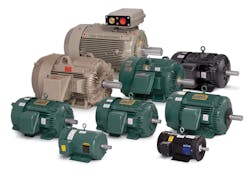Motors up, Emissions down: ABB-NEMA leader talks Energy Efficiency from Rooftop to Rotor
What in the name of Michael Faraday is going on?
In what may be the greatest energy evolution since those original and historic electromagnetic experiments, the desire to participate in the decarbonization of power is proving magnetic. It is irresistibly drawing companies from every walk of the economy, aiming for cleaner operations and lower pollution as our planet continues to bake. (See cloudy London’s temperature lately, for reference).
It’s been a hot minute since every firm with a sense of public decorum has talked like they don’t care about climate change. The titans of industry are now tech giants such as Amazon, Alphabet and Microsoft, all vowing to reach Net-Zero carbon goals within the next few decades.
Grid technology firms like ABB have been rushing to meet the market desire for decarbonization. This includes e-mobility solutions such as electric vehicle charging infrastructure as well as digitalization and infrastructure advancements with switchgear and other equipment.
One possibly unsung tip of the spear leading the energy transition charge is energy efficiency. Often called “the first fuel” because it can make the initial and biggest unseen impact on carbon reduction, energy efficiency can involve upgrades to make buildings and industrial operations less energy-leaky, but also revolutionize the way they power those buildings.
ABB’s NEMA Motors division, which continues to operate out of Fort Smith, Arkansas, supplies millions of electric motors, from one to 500 horsepower, to customers in commercial and industrial sectors. These include motors which can drive not only cooling fans, but also empower large rooftop HVAC units, giant fluid pumps and heavy duty tools.
Some believe that energy efficiency can help reduce greenhouse gas emissions by as much as 30 percent in coming years if the right electrification strategy is implemented and effective.
“Ninety-six percent of our customers in the U.S. are investing in energy efficiency,” said Jesse Henson, president of NEMA Motors-ABB, during interviews prior to the ABB Formula E NYC E-Prix electric auto races in Brooklyn. “The most sustainable solution is never to use the energy in the first place.”
NEMA, which ABB acquired with its Baldor Electric deal in the early 2010s, mainly supplies motors to industrial customers. The industrial sector accounts for about 25 percent of overall U.S. GHG emissions, according to federal data.
That leaves plenty of room for improvement if the right technology is in place. Whether it’s a manufacturing plant, a mining operation or a data center, the potential for achieving both energy resiliency and greater efficiency is enormous, Henson believes.
“The power to make everything move is from the electric motor,” he pointed out. “Think how much energy they can drive (and replace gas or coal-fired predecessors)?”
The latest generation of electric motor technology is stiving to offer the same energy density of fossil fuel powered tools. But, Henson stressed, the key is to update and elevate—swapping out an old motor for a new 50-horsepower model can avoid 24 metric tons of pollution per machine per year.
NEMA employs man-made permanent magnets in the motors instead of rare earth elements, a move which both contains cost and shortens the supply chain issues. Integrating the motor with the drive also is proving to be an important consolidation and improvement.
Electric motors often last some 20 years, so only five percent of the cost is in the initial investment, while that other 95 percent is in energy expenses which can be curtailed with upgraded equipment, Henson noted. Electrification via new motors often can see a payback as short as in 18 months.
See our full coverage of the Energy Efficiency sector
Beneficial Electrification mandate provides Holiday Bonus for Fed Building Decarbonization
Subscribe to EnergyTech's free newsletter for deeper insights into the C&I Energy Transition
NEMA also eyes the data center industry as perhaps the biggest growth market. Millions of facilities are in operation globally and consuming as much as 200 terawatt hours annually depending on the estimates.
The world’s information technology owners talk about sustainability goals and renewable energy “virtual” power purchase agreements which are often indirect and mainly headline investments, but those plants really need reliable electric power which must be resilient and efficient.
Henson pointed to a key necessity for electrification of fans in the facilities, for instance. Data centers, after all, need to be calm, cool and decarbonized.
A megawatt saved, in other words, is clean energy earned no matter what.
“People don’t always get the full picture of what they can do (with electrification of motors) and the energy they can save,” Henson said.
-- -- --
(Rod Walton, senior editor for EnergyTech, is a 14-year veteran of covering the energy industry both as a newspaper and trade journalist. He can be reached at [email protected]).
About the Author
Rod Walton, EnergyTech Managing Editor
Managing Editor
For EnergyTech editorial inquiries, please contact Managing Editor Rod Walton at [email protected].
Rod Walton has spent 17 years covering the energy industry as a newspaper and trade journalist. He formerly was energy writer and business editor at the Tulsa World. Later, he spent six years covering the electricity power sector for Pennwell and Clarion Events. He joined Endeavor and EnergyTech in November 2021.
Walton earned his Bachelors degree in journalism from the University of Oklahoma. His career stops include the Moore American, Bartlesville Examiner-Enterprise, Wagoner Tribune and Tulsa World.
EnergyTech is focused on the mission critical and large-scale energy users and their sustainability and resiliency goals. These include the commercial and industrial sectors, as well as the military, universities, data centers and microgrids. The C&I sectors together account for close to 30 percent of greenhouse gas emissions in the U.S.
He was named Managing Editor for Microgrid Knowledge and EnergyTech starting July 1, 2023
Many large-scale energy users such as Fortune 500 companies, and mission-critical users such as military bases, universities, healthcare facilities, public safety and data centers, shifting their energy priorities to reach net-zero carbon goals within the coming decades. These include plans for renewable energy power purchase agreements, but also on-site resiliency projects such as microgrids, combined heat and power, rooftop solar, energy storage, digitalization and building efficiency upgrades.


